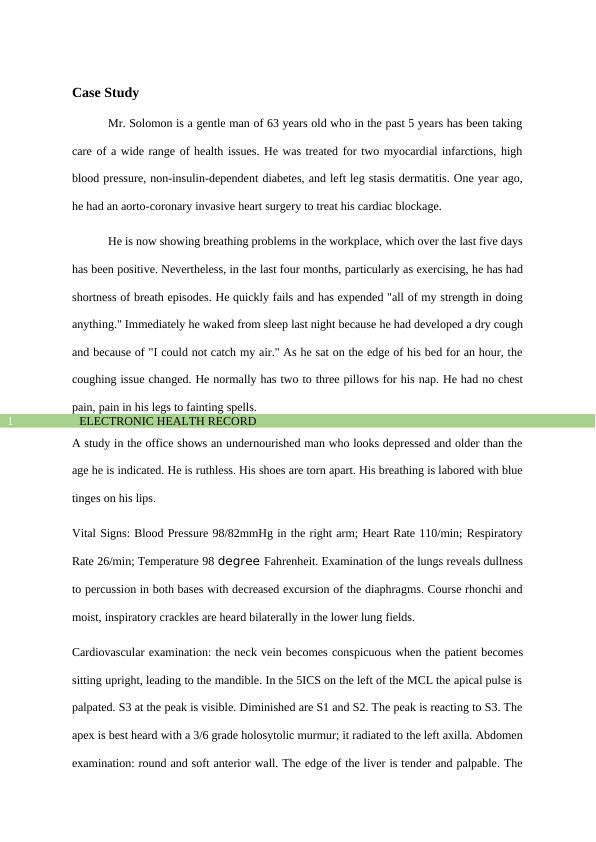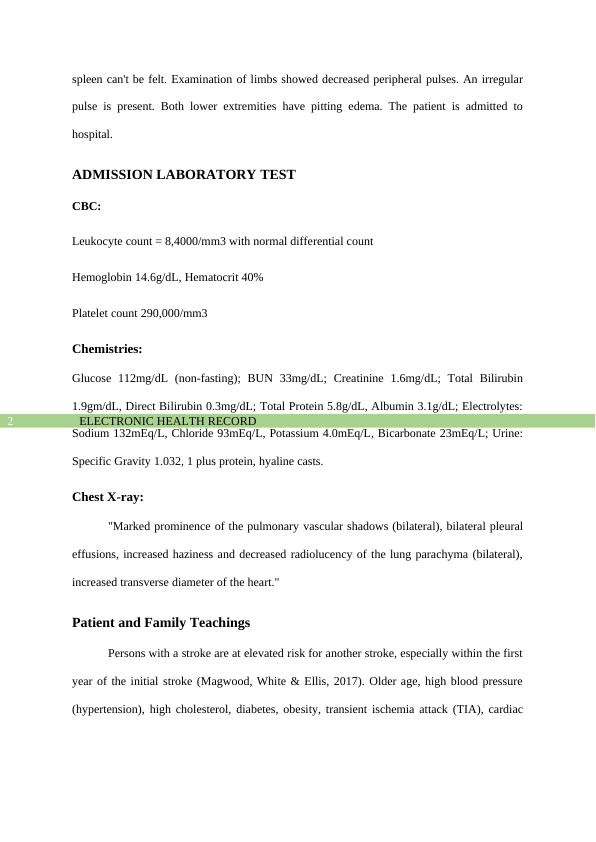Assignment on Electronic Health Record
Added on 2022-08-19
8 Pages2109 Words13 Views
Running head: FAMILY NURSING
Case Study
Name of the Student:
Name of the University:
Author Note:
Case Study
Name of the Student:
Name of the University:
Author Note:

ELECTRONIC HEALTH RECORD1
Case Study
Mr. Solomon is a gentle man of 63 years old who in the past 5 years has been taking
care of a wide range of health issues. He was treated for two myocardial infarctions, high
blood pressure, non-insulin-dependent diabetes, and left leg stasis dermatitis. One year ago,
he had an aorto-coronary invasive heart surgery to treat his cardiac blockage.
He is now showing breathing problems in the workplace, which over the last five days
has been positive. Nevertheless, in the last four months, particularly as exercising, he has had
shortness of breath episodes. He quickly fails and has expended "all of my strength in doing
anything." Immediately he waked from sleep last night because he had developed a dry cough
and because of "I could not catch my air." As he sat on the edge of his bed for an hour, the
coughing issue changed. He normally has two to three pillows for his nap. He had no chest
pain, pain in his legs to fainting spells.
A study in the office shows an undernourished man who looks depressed and older than the
age he is indicated. He is ruthless. His shoes are torn apart. His breathing is labored with blue
tinges on his lips.
Vital Signs: Blood Pressure 98/82mmHg in the right arm; Heart Rate 110/min; Respiratory
Rate 26/min; Temperature 98 degree Fahrenheit. Examination of the lungs reveals dullness
to percussion in both bases with decreased excursion of the diaphragms. Course rhonchi and
moist, inspiratory crackles are heard bilaterally in the lower lung fields.
Cardiovascular examination: the neck vein becomes conspicuous when the patient becomes
sitting upright, leading to the mandible. In the 5ICS on the left of the MCL the apical pulse is
palpated. S3 at the peak is visible. Diminished are S1 and S2. The peak is reacting to S3. The
apex is best heard with a 3/6 grade holosytolic murmur; it radiated to the left axilla. Abdomen
examination: round and soft anterior wall. The edge of the liver is tender and palpable. The
Case Study
Mr. Solomon is a gentle man of 63 years old who in the past 5 years has been taking
care of a wide range of health issues. He was treated for two myocardial infarctions, high
blood pressure, non-insulin-dependent diabetes, and left leg stasis dermatitis. One year ago,
he had an aorto-coronary invasive heart surgery to treat his cardiac blockage.
He is now showing breathing problems in the workplace, which over the last five days
has been positive. Nevertheless, in the last four months, particularly as exercising, he has had
shortness of breath episodes. He quickly fails and has expended "all of my strength in doing
anything." Immediately he waked from sleep last night because he had developed a dry cough
and because of "I could not catch my air." As he sat on the edge of his bed for an hour, the
coughing issue changed. He normally has two to three pillows for his nap. He had no chest
pain, pain in his legs to fainting spells.
A study in the office shows an undernourished man who looks depressed and older than the
age he is indicated. He is ruthless. His shoes are torn apart. His breathing is labored with blue
tinges on his lips.
Vital Signs: Blood Pressure 98/82mmHg in the right arm; Heart Rate 110/min; Respiratory
Rate 26/min; Temperature 98 degree Fahrenheit. Examination of the lungs reveals dullness
to percussion in both bases with decreased excursion of the diaphragms. Course rhonchi and
moist, inspiratory crackles are heard bilaterally in the lower lung fields.
Cardiovascular examination: the neck vein becomes conspicuous when the patient becomes
sitting upright, leading to the mandible. In the 5ICS on the left of the MCL the apical pulse is
palpated. S3 at the peak is visible. Diminished are S1 and S2. The peak is reacting to S3. The
apex is best heard with a 3/6 grade holosytolic murmur; it radiated to the left axilla. Abdomen
examination: round and soft anterior wall. The edge of the liver is tender and palpable. The

ELECTRONIC HEALTH RECORD2
spleen can't be felt. Examination of limbs showed decreased peripheral pulses. An irregular
pulse is present. Both lower extremities have pitting edema. The patient is admitted to
hospital.
ADMISSION LABORATORY TEST
CBC:
Leukocyte count = 8,4000/mm3 with normal differential count
Hemoglobin 14.6g/dL, Hematocrit 40%
Platelet count 290,000/mm3
Chemistries:
Glucose 112mg/dL (non-fasting); BUN 33mg/dL; Creatinine 1.6mg/dL; Total Bilirubin
1.9gm/dL, Direct Bilirubin 0.3mg/dL; Total Protein 5.8g/dL, Albumin 3.1g/dL; Electrolytes:
Sodium 132mEq/L, Chloride 93mEq/L, Potassium 4.0mEq/L, Bicarbonate 23mEq/L; Urine:
Specific Gravity 1.032, 1 plus protein, hyaline casts.
Chest X-ray:
"Marked prominence of the pulmonary vascular shadows (bilateral), bilateral pleural
effusions, increased haziness and decreased radiolucency of the lung parachyma (bilateral),
increased transverse diameter of the heart."
Patient and Family Teachings
Persons with a stroke are at elevated risk for another stroke, especially within the first
year of the initial stroke (Magwood, White & Ellis, 2017). Older age, high blood pressure
(hypertension), high cholesterol, diabetes, obesity, transient ischemia attack (TIA), cardiac
spleen can't be felt. Examination of limbs showed decreased peripheral pulses. An irregular
pulse is present. Both lower extremities have pitting edema. The patient is admitted to
hospital.
ADMISSION LABORATORY TEST
CBC:
Leukocyte count = 8,4000/mm3 with normal differential count
Hemoglobin 14.6g/dL, Hematocrit 40%
Platelet count 290,000/mm3
Chemistries:
Glucose 112mg/dL (non-fasting); BUN 33mg/dL; Creatinine 1.6mg/dL; Total Bilirubin
1.9gm/dL, Direct Bilirubin 0.3mg/dL; Total Protein 5.8g/dL, Albumin 3.1g/dL; Electrolytes:
Sodium 132mEq/L, Chloride 93mEq/L, Potassium 4.0mEq/L, Bicarbonate 23mEq/L; Urine:
Specific Gravity 1.032, 1 plus protein, hyaline casts.
Chest X-ray:
"Marked prominence of the pulmonary vascular shadows (bilateral), bilateral pleural
effusions, increased haziness and decreased radiolucency of the lung parachyma (bilateral),
increased transverse diameter of the heart."
Patient and Family Teachings
Persons with a stroke are at elevated risk for another stroke, especially within the first
year of the initial stroke (Magwood, White & Ellis, 2017). Older age, high blood pressure
(hypertension), high cholesterol, diabetes, obesity, transient ischemia attack (TIA), cardiac

End of preview
Want to access all the pages? Upload your documents or become a member.
Related Documents
Cerebral Hemorrhage and Hypertension PDFlg...
|22
|4228
|137
Summative Essay.lg...
|17
|5119
|16
MHS1102: Anatomy and Physiology | Case Studylg...
|5
|1441
|734
Case Study on Diabetes Managementlg...
|12
|3452
|137
Nursing Management of the Patient with a Complex Condition Assessment 2022lg...
|9
|3003
|23
NURS3002: Therapeutic & Professional Relationshiplg...
|12
|4296
|26
